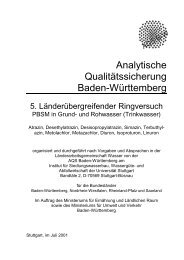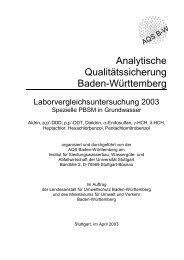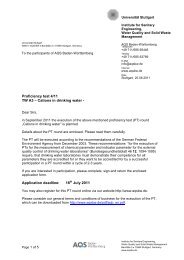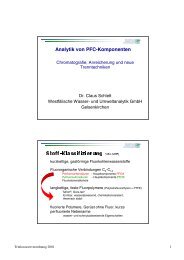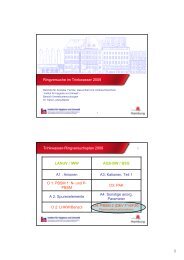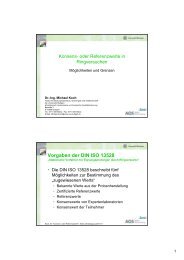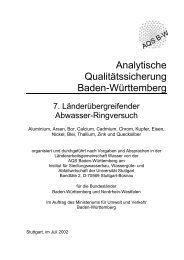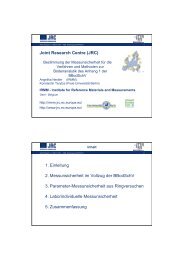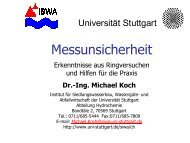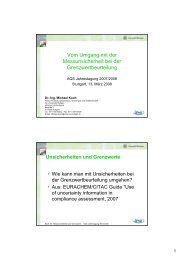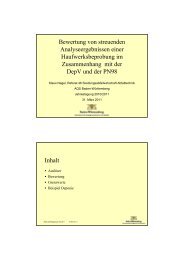Institute for Sanitary Engineering, Water Quality and Solid Waste ...
Institute for Sanitary Engineering, Water Quality and Solid Waste ...
Institute for Sanitary Engineering, Water Quality and Solid Waste ...
Create successful ePaper yourself
Turn your PDF publications into a flip-book with our unique Google optimized e-Paper software.
<strong>Waste</strong> <strong>Water</strong> Technology AWT<br />
Research <strong>for</strong> further P-elimination in Stuttgart’s<br />
wastewater treatment plants in the Neckar<br />
catchment area in the context of implementing<br />
the WFD<br />
As part of the EU <strong>Water</strong> Framework Directive (WFD)<br />
implementation in the Neckar catchment area, a study<br />
was based <strong>and</strong> prepared at the <strong>Institute</strong> <strong>for</strong> <strong>Sanitary</strong><br />
<strong>Engineering</strong>, <strong>Water</strong> <strong>Quality</strong> <strong>and</strong> <strong>Solid</strong> <strong>Waste</strong> Management<br />
(ISWA), covering the major wastewater treatment<br />
plants in the Neckar catchment area <strong>and</strong> dealing<br />
with more stringent requirements <strong>for</strong> the discharged<br />
phosphorus load.<br />
There<strong>for</strong>e, on behalf of the Stuttgart city drainage company<br />
(SES), it was investigated which total phosphorus<br />
(Ptot) monitoring values at the wastewater treatment<br />
plants outside Stuttgart can be met without introducing<br />
any additional procedural steps <strong>for</strong> phosphorus<br />
removal. For the group of wastewater treatment plants<br />
WWTP Ditzingen <strong>and</strong> WWTP Plieningen detailed studies<br />
are conducted, whose results are transferred to<br />
the sewage treatment plant Möhringen.<br />
As a first step, the daily operation records of the treatment<br />
plant from years 2007 <strong>and</strong> 2008 were reviewed.<br />
It was found that, <strong>for</strong> both particulate <strong>and</strong> dissolved<br />
organic phosphorus compounds at the outflow of the<br />
treatment plants, no additional action was needed because<br />
the measured concentrations were in the expected<br />
range. Accordingly, the existing scope <strong>for</strong> action<br />
was primarily in a reduction of the o-phosphate<br />
concentration in the effluent of the wastewater treatment<br />
plants.<br />
For rapid <strong>and</strong> systematic implementation of the studies,<br />
a statistical method was developed at ISWA <strong>for</strong><br />
the analysis of routinely collected data <strong>and</strong>, there<strong>for</strong>e,<br />
improvement of the available phosphorus data, which<br />
provides reliable <strong>and</strong> comparable results to evaluate<br />
the achievable Ptot concentrations.<br />
Key point of the evaluation is the verifiable statistical<br />
independence of the o-phosphate concentrations<br />
of the remaining phosphate fractions, i.e. essentially<br />
the particulate <strong>and</strong> dissolved organic phosphate compounds.<br />
The coupling of high-resolution data on the<br />
o-phosphate concentrations in the effluent of the activated<br />
sludge process with a probability distribution<br />
of these remaining phosphate fractions, taken from<br />
the operation diaries of 2007 <strong>and</strong> 2008, lead to highresolution<br />
probability values <strong>for</strong> P tot concentrations in<br />
the effluent. As agreed with SES, the goal was to reach<br />
a 90% probability of compliance with the monitoring<br />
values in the qualified sample. In the analysis of the<br />
data, the proportion of the collected high-resolution<br />
data points, which do not meet this requirement, was<br />
increased. This parameter is used as a comparison<br />
between the various stages of investigation <strong>and</strong> allows<br />
making conclusions on compliance with various assumed<br />
surveillance values.<br />
Prerequisite <strong>for</strong> the application of the developed evaluation<br />
method is, firstly, the likelihood of giving accurate<br />
high-resolution o-phosphate values. The data<br />
will be collected online <strong>for</strong> the wastewater treatment<br />
plants outside Stuttgart at the outflow of the activated<br />
sludge tanks. The quality of the data <strong>for</strong> the group<br />
of wastewater treatment plants Ditzingen <strong>and</strong> WWTP<br />
Plieningen has been considered sufficient. In the case<br />
of WWTP Ditzingen, however, the o-phosphate concentration<br />
values after the secondary sedimentation<br />
increased, which was considered with an impact factor.<br />
The second prerequisite <strong>for</strong> the application of the method<br />
lies in the comparability of the probability distribution<br />
of the remaining phosphate fractions between<br />
measurements campaign <strong>and</strong> the operation diaries<br />
2007-2008. These are the adequate measures taken<br />
<strong>for</strong> the wastewater treatment plants.<br />
With the help of the developed statistical methods, it<br />
was shown that, in the case of the group of wastewater<br />
treatment plants Ditzingen, compliance with the stringent<br />
monitoring values is possible with a very high<br />
probability, without any additional procedural steps,<br />
only by an appropriate dosage of a precipitation agent.<br />
Regarding the WWTP Plieningen, it can be concluded<br />
that a significant increase of the phosphorus monitoring<br />
value can be accomplished without a problem.<br />
Funding:<br />
Eigenbetrieb Stadtentwässerung Stuttgart<br />
Funding Duration:<br />
01/2009 - 12/2009<br />
Project Manager:<br />
Prof. Dr.-Ing. H. Steinmetz<br />
Project Coordinator:<br />
Dipl.-Ing. RBM C. Meyer<br />
Contact Person:<br />
Dipl.-Ing. Andreas Neft, Dipl.-Ing. Sabine Schmidt<br />
25




